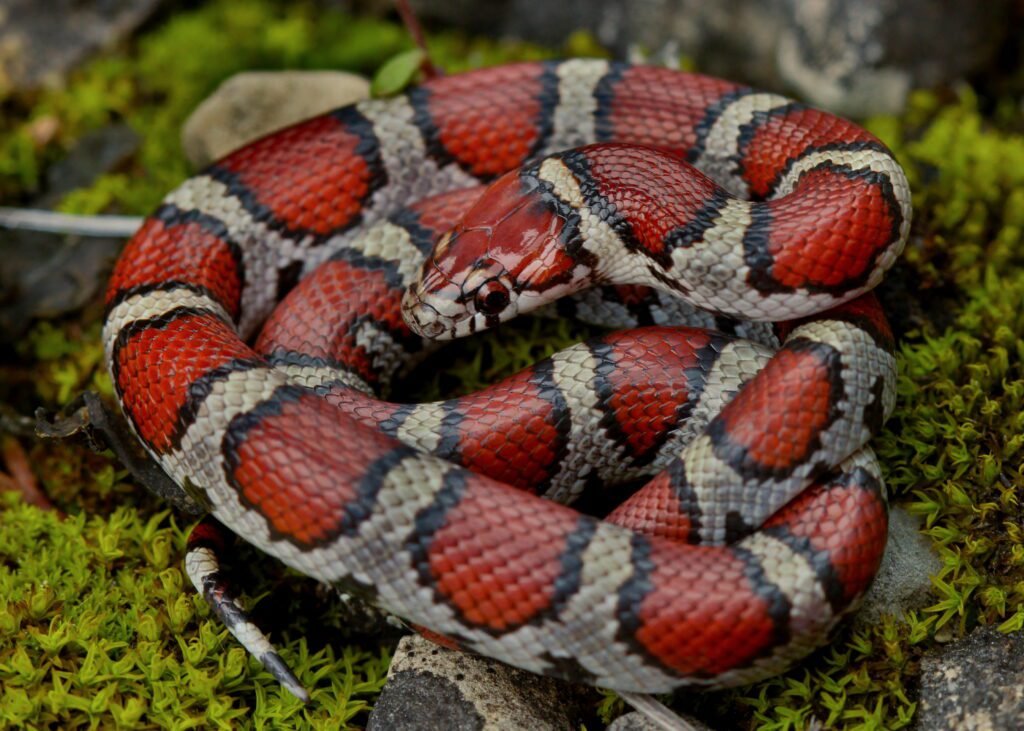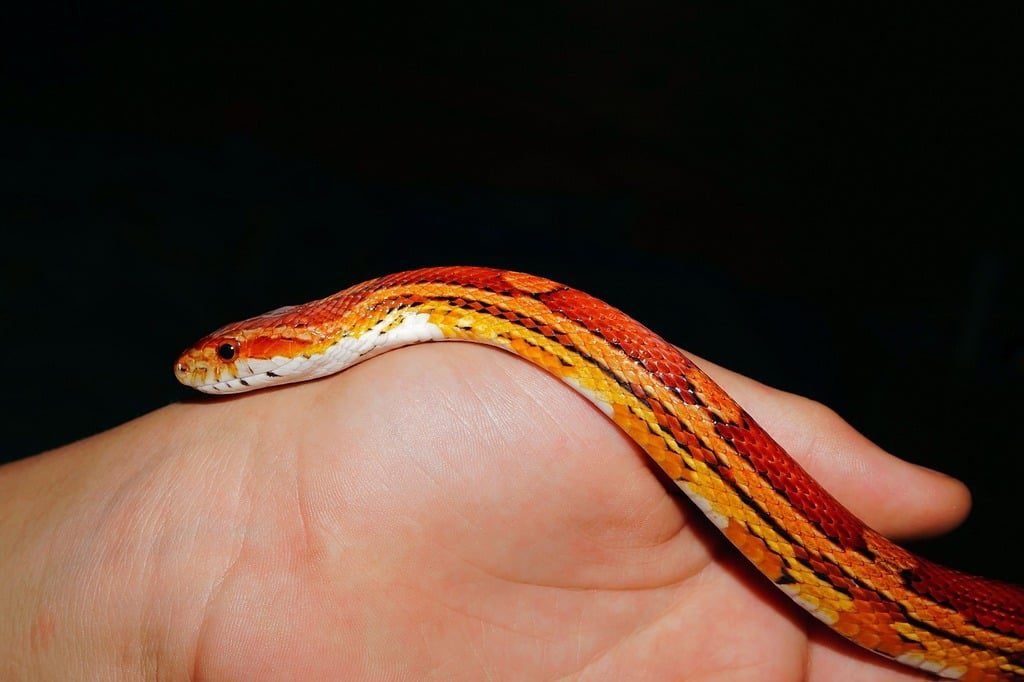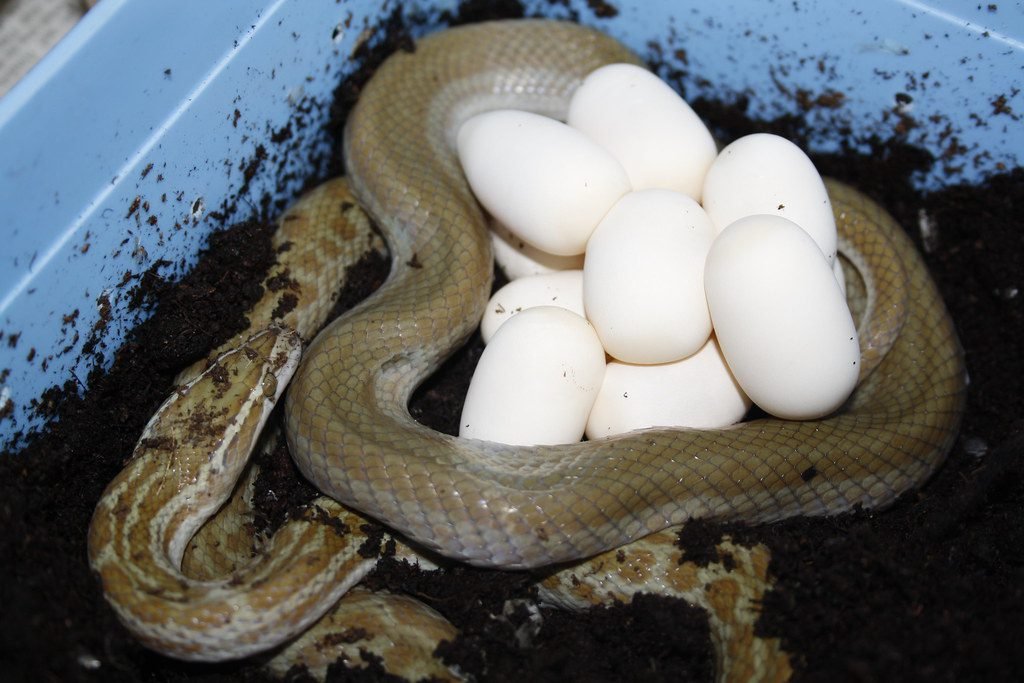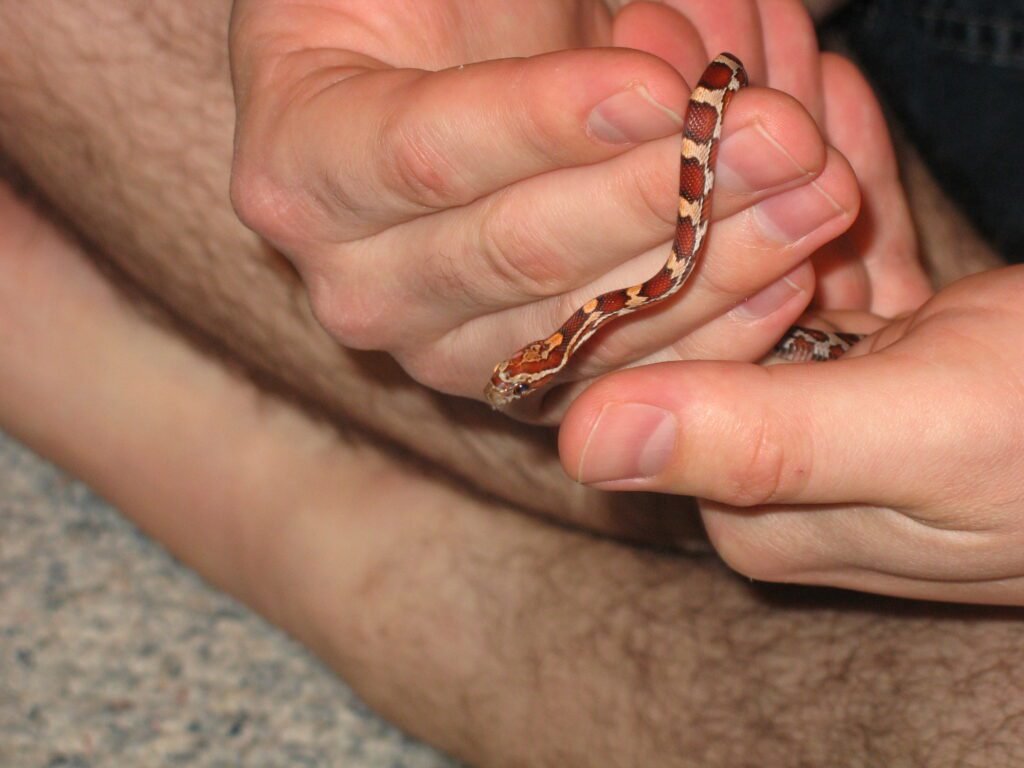


Learn If Birds Can Smell Food Put in the Feeder [2024 Guide]
December 31, 2023


Mourning Dove Spiritual Meaning (+Dreams, Spirit, Power & Totem)
January 3, 2024For many individuals, snakes are often viewed as dangerous creatures better left in their natural habitats. However, those who appreciate snakes understand that certain species do not merit this negative perception.
Species such as the corn and milk snakes are gentle snakes that are simple to care for. Contrary to what some might think, these species can be domesticated as pets.
Many enthusiasts considering adopting a snake as a pet often find themselves in a dilemma, especially when choosing between corn and milk snakes. Both species are frequently recommended as ideal pets, particularly for those new to snake ownership.
To make an informed decision, it’s essential to understand the similarities and differences between a milk snake and a corn snake.
Milk Snake vs Corn Snake
Corn and milk snakes are excellent choices for beginner snake owners because of their small size and simple care needs. While corn snakes are generally calmer, milk snakes can be slightly more intense, but their differences are slight.
Ultimately, choosing the right snake comes down to personal preference.
Continue reading to discover more about the distinct characteristics of corn and milk snakes, which will assist you in determining the most suitable option.
History of Milk Snake & Corn Snake
Milk Snake: The Milk Snake (Lampropeltis triangulum) gets its name from an old myth about milking cows, due to their presence in barns where they actually hunted rodents. This non-venomous species, known for its vibrant coloration that mimics the venomous coral snake, has been historically valued for pest control and studied for its evolutionary biology.


Eastern Milksnake
Corn Snake: Corn Snakes (Pantherophis guttatus), indigenous to the southeastern United States, are named for their common presence in corn storage areas, where they helped control rodent populations. Their role in agricultural pest management and their docile nature have made them popular pets and subjects of herpetological research.


Cornsnake
Differences & Similarities Between Corn And Milk Snakes
Here are a few primary differences between milk and corn snakes:
1: Appearance
Corn snakes are characterized by their reddish base color decorated with brown, orange, and red patterns and a distinct black and white checkered pattern on their belly scales. In contrast, milk snakes exhibit a more vibrant appearance with a base color of white, orange, or yellow, complemented by white, black, or red stripes sharply defined by black bands.
The patterning of milk snakes is notably more pronounced, and their colors are typically brighter, setting them apart from corn snakes.
Both species are often mistaken for other snakes. Corn snakes are sometimes incorrectly identified as the venomous copperhead, while milk snakes are occasionally confused with the venomous coral snake.
Regarding color variations, both species offer a range, but corn snakes have a more extensive selection. Over 800 color morphs are available for corn snakes, compared to the 24 recognized color morphs for milk snakes.
2: Size
Corn snakes and milk snakes share a similarity in their relatively modest size. Corn snakes are moderately sized, typically reaching up to 6 feet long and weighing around 2 pounds. On the other hand, milk snakes are generally smaller, with an average length of 3 feet and a weight range of 1-3 pounds.
The record length for a corn snake is 6 feet, while some milk snakes may occasionally grow slightly over 5 feet, though this is rare.


Corn snake in hand
Given their smaller size, both snakes are easy to manage and do not necessitate a complex habitat.
Regarding gender differences, female corn snakes usually grow larger than their male counterparts, whereas, for milk snakes, the males are typically larger than the females.
3: Habitat
Corn and milk snakes exhibit adaptability in their natural environments, thriving in various habitats. Both are commonly found in grasslands, forest fringes, and rocky hillside areas.
Corn snakes have a particular affinity for inhabiting artificial structures, especially abandoned ones. However, they are slightly less adaptable than milk snakes regarding habitat variety, as they typically avoid coastal regions.
On the other hand, milk snakes are often seen near water sources such as rivers, swamps, and streams.
Although both species primarily reside on the ground, they are known to climb trees occasionally, particularly when pursuing food.
Geographically, milk snakes are widespread across North, Central, and South America. Corn snakes, native to the Eastern United States, are most prevalent in the Southeastern states, including Florida and South Carolina.
4: Enclosure Requirement
Corn and milk snakes share similar enclosure requirements, including tank size, temperature settings, and lighting. The primary distinction lies in their humidity needs; corn snakes require more humidity than milk snakes.
For proper accommodation, the tank should be at least as long as the snake, allowing it to stretch out fully. A 75-gallon tank is suitable for either an adult corn snake or an adult milk snake.


Snake Enclosure
Both species benefit from having a temperature gradient in their habitat. The cooler side should be maintained at around 75°F (24°C), with a basking area reaching 90°F (32°C).
Although UVB lighting isn’t typically necessary for snakes, ensuring a regular day-night light cycle is essential for maintaining their circadian rhythm.
The major distinction in their habitats is the level of humidity. Milk snakes thrive in environments with humidity levels between 40% and 60%, whereas corn snakes need a more humid climate, with humidity ranging from 65% to 75%.
5: Behavior & Personality
Corn snakes and milk snakes differ in their behavior and temperament.
Although both species are generally gentle, milk snakes can become stressed more easily than corn snakes. A calm milk snake might release musk or display aggressive behavior when stressed. In contrast, corn snakes are known for their peaceful nature and rarely exhibit stress or aggression towards their owners.
Their daily activity patterns also vary. Corn snakes are diurnal, meaning they are active primarily during the day. Milk snakes, however, are nocturnal and tend to be more active at night.
Despite these differences, both types of snakes can enjoy human interaction. Once they become accustomed to their owner, they often appreciate being handled. Regularly allowing them out of their enclosure is beneficial for their well-being, allowing them to stretch and exercise.
6: Dietary Needs
Corn and milk snakes have similar dietary preferences, primarily feeding on small rodents. In the wild, they may hunt live prey, but offering frozen-thawed rodents is safer for pet snakes to prevent potential injuries from live mice.
It’s essential to ensure that the size of the prey is not more significant than the snake’s body circumference to facilitate easy swallowing and digestion.
Young snakes, or hatchlings, typically consume small fuzzy or pinkie mice, while adult snakes can handle adult mice or small rats. Before feeding, frozen mice should always be thoroughly thawed.


Snake Eating a Frog
Fresh, clean water should be available to your snake daily.
In terms of feeding habits, corn snakes are generally more accommodating. They readily accept food offered with tongs, whereas milk snakes may initially shy away from tongs.
Hand-feeding milk snakes might lead to accidental bites, but they can learn to accept food from tongs with patience.
If bitten by either a corn snake or a milk snake, the experience is unlikely to be very painful due to their tiny teeth.
7: Lifespan
In captivity, corn snakes and milk snakes can share a similar lifespan, often living up to 20 years with proper care, significantly longer than their typical lifespan in the wild.
Corn snakes usually survive 6-8 years in their natural habitats, whereas milk snakes can live up to 15 years.
The record for the longest-lived corn snake in captivity is just over 32 years. The reduced lifespan of these snakes in the wild is mainly due to the presence of various predators.
Common threats for milk snakes include coyotes and raccoons preying on the older ones, while bullfrogs and birds often target younger milk snakes.
Corn snakes face a range of predators, including foxes, coyotes, bobcats, hawks, raccoons, possums, weasels, and even other snakes.
8: Breeding
Generally, corn snakes are simpler to breed and produce a larger number of eggs, whereas breeding milk snakes are more challenging, and they lay fewer eggs.
Corn snakes require a brumation period of about 90 days for successful breeding to prepare their bodies. Female corn snakes can lay between 12 to 24 eggs per clutch, which typically hatch after approximately 10 weeks. Newborn corn snakes measure around 5 inches in length.


Snake Eggs
In contrast, breeding milk snakes involves mating from early May to late June. Female milk snakes lay up to 10 eggs per clutch, which hatch in about two months. The hatchlings of milk snakes are slightly larger, measuring just over 8 inches at birth.
Are These Snakes Venomous?
Corn snakes and milk snakes are both non-venomous species. Common among non-venomous snakes, they possess round pupils and smaller teeth. Lacking venom for defense in the wild, these snakes use alternative strategies for protection.
In dangerous situations, corn snakes typically opt to escape but will bite if necessary. Although a bite from a corn snake isn’t overly painful, there’s a risk of infection due to bacteria in the snake’s mouth. Corn snakes suppress their prey through constriction, wrapping their bodies around the prey until it is hindered or ceases breathing.


Venomous Snakes
Milk snakes, conversely, use mimicry as a defense mechanism, their coloring resembling the venomous coral snake. This resemblance often misleads predators in the wild, who mistake the milk snake’s bright colors as a sign of danger.
Additionally, milk snakes can imitate rattlesnakes by vibrating their tails in dry leaves to produce a sound similar to a rattlesnake’s rattle.
Handling and Temperament
When it comes to handling and temperament, Corn Snakes and Milk Snakes present noticeable differences, making them suitable for various types of owners.
Corn Snakes are renowned for their docile nature, making them ideal for beginners. They generally tolerate handling well, rarely showing signs of stress or aggression, which contributes to their popularity as pets.


Young Corn Snake
Milk Snakes, while also gentle, can be a bit more skittish and may exhibit stress more easily, especially when not accustomed to regular handling. They might release musk or show defensive behavior if they feel threatened. However, with consistent and gentle handling, Milk Snakes can become more comfortable with human interaction.
Both species require patience and gentle handling to build trust, but Corn Snakes typically adapt more quickly to regular handling, making them a more straightforward choice for first-time snake owners.
Cost Price Of Corn & Milk Snakes
The cost of acquiring corn snakes and milk snakes varies slightly due to their prevalence. Corn snakes, being more common, are generally more affordable, including their morph varieties. In contrast, milk snakes are less common and thus typically carry a higher price tag.
On average, a standard corn snake is priced at about $50, whereas rare morphs of corn snakes can cost as much as $1,000.
For milk snakes, the average cost ranges from $50 to $100. The price for milk snake morphs can vary between $250 and $1,000, depending on their rarity.
Both types of snakes can be conveniently purchased from online breeders. While corn snakes may be available at local pet stores, finding milk snakes in such stores is rare.
Milk Snake Or Corn Snake: Which Is A Better Pet For Beginners?
Corn and milk snakes are suitable for those new to snake ownership, thanks to their manageable size, lack of venom, and generally gentle demeanor.
For beginners who prefer a snake with a lower tendency to bite, the corn snake is often the ideal option.
Here’s a comparison table to help you decide between both:
| Feature | Corn Snake | Milk Snake |
|---|---|---|
| Appearance | Reddish base with brown, orange, and red patterns; black and white checkered belly. | Base color of white, orange, or yellow with sharply defined stripes and bands in white, black, or red. |
| Size | Up to 6 feet long, around 2 pounds. | Average 3 feet long, 1-3 pounds. |
| Habitat Preferences | Grasslands, forest fringes, abandoned structures. | Near water sources, grasslands, rocky areas. |
| Enclosure Requirement | 75-gallon tank, temperature gradient, higher humidity (65-75%). | 75-gallon tank, temperature gradient, lower humidity (40-60%). |
| Behavior & Personality | Gentle, diurnal, and less likely to show stress. | Can be stressed easily, nocturnal, might release musk or show aggression when stressed. |
| Dietary Needs | Small rodents, are more accommodating in feeding. | Small rodents, might shy away from tongs initially. |
| Lifespan | Up to 20 years in captivity. | Up to 20 years in captivity. |
| Breeding | Easier to breed, 12-24 eggs per clutch. | More challenging, up to 10 eggs per clutch. |
| Venomous? | No | No |
| Cost | Average $50, rare morphs up to $1,000. | Average $50-$100, rare morphs $250-$1,000. |
| Suitability for Beginners | It is ideal for beginners. | Suitable, but can be slightly more intense. |
Conclusion
The milk snake and the corn snake are both great pets for new and old pet parents. Their personality, lovely appearance, and size can easily fit into any home.
Getting either one requires a lot of commitment, and if you’re a new pet parent, you should ensure you gain enough knowledge to take care of your pet snake.



